Too
often we encounter troubles because we act first and think later.
That’s why when planting an orchard (or even a few trees in the
backyard), it’s a good idea to take a step back and visualize how our
efforts will look 10 years from now. Remember, the time difference
between a vegetable garden and producing fruit trees can be years! Let’s avoid future problems by following a few key planning steps to successful planting:
1. The Planting Site
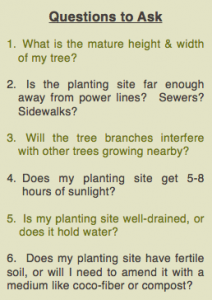
Have you chosen a place free of interference? Is it far enough from power lines, sewer lines, sidewalks, etc.? Visualize your tree 10 years from now in the location you’ve chosen, and ask yourself those questions. If your tree could talk, it would ask for a well-drained, fertile location with plenty of sunlight. While a full day’s sun is great, trees can still thrive and produce on a half-day’s light; and most trees are forgiving of imperfect soil conditions. If your ground is a little heavy, consider using a good potting mix . Then, when refilling the hole, work the mix into the soil and finish planting. This will give the root system air and allow for water absorption as the roots develop.
2. Digging the Hole
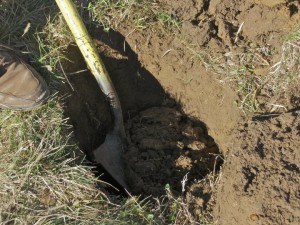 When
digging the hole, a good rule of thumb is to remove a space nearly
twice the width and depth of the roots. You don’t want the roots cramped
or circled. The area you loosen is the area the roots will quickly grow
into to anchor and sustain the tree’s top.
This simple task helps determine both how good the foundation will be
years later and how well the plant utilizes two much-needed ingredients:
air and water.
When
digging the hole, a good rule of thumb is to remove a space nearly
twice the width and depth of the roots. You don’t want the roots cramped
or circled. The area you loosen is the area the roots will quickly grow
into to anchor and sustain the tree’s top.
This simple task helps determine both how good the foundation will be
years later and how well the plant utilizes two much-needed ingredients:
air and water. 3. Planting the Tree
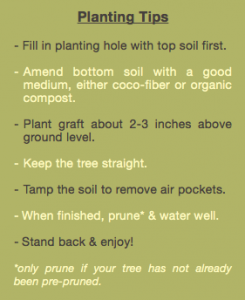 The Soil
The SoilSoil preparation can be done at any time of year that the ground is not overly saturated with water or frozen. Adding organic materials like compost will improve the composition of most every soil type. Organic materials bind sandy soil particles so they retain moisture and nutrients better. They also break apart clay and silt particles, so that water can soak in and roots can spread. You know the soil you dug up first, right underneath the grass? When refilling your planting hole, it’s always best to place that soil in first. It’s usually more fertile, as well as more porous, and when placed down near the roots, it will help the tree grow better. The remaining soil (from the bottom of the dug hole) is heavier and works well when mixed with the good potting mix. From top to bottom, work the soil with your hands to avoid large clods that create air pockets.
Graft Placement
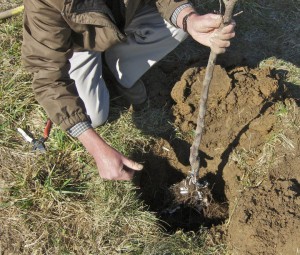 When
you refill your planting hole, hold the tree up a bit to allow loose
soil to fall beneath, as well as around the sides of, the roots. Center
its position so there is adequate
space on all four sides for the root system to grow out.
When
you refill your planting hole, hold the tree up a bit to allow loose
soil to fall beneath, as well as around the sides of, the roots. Center
its position so there is adequate
space on all four sides for the root system to grow out.
If you are
planting a dwarf or semi-dwarf apple tree, hold the bud (graft) union up
above the refill line at least 3 inches. If given the opportunity,
grafted apple trees will self-root from above the graft union; if the
variety self-roots, you’ll lose the size-restrictive nature of the
rootstock.
Did you
know the rootstock is responsible for the mature size of your tree,
i.e. dwarf, semi-dwarf, standard? We don’t want to lose that sizing—it
would definitely throw a rock in your long-term plan!
Finishing Touches
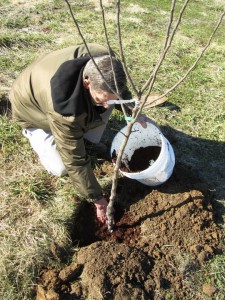
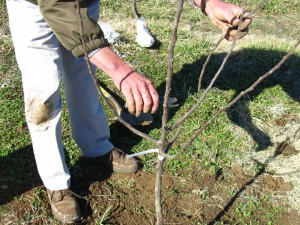 Through
the process, keep the tree straight (perpendicular) and upon finishing,
tamp the tree in with your foot to remove air spaces and seal it in. If
the tree is
planted on a slope, create a slight berm on the lower side to utilize
water throughout the summer. If it’s not pre-pruned before you plant
it, be sure to prune your tree, and water it well.
Through
the process, keep the tree straight (perpendicular) and upon finishing,
tamp the tree in with your foot to remove air spaces and seal it in. If
the tree is
planted on a slope, create a slight berm on the lower side to utilize
water throughout the summer. If it’s not pre-pruned before you plant
it, be sure to prune your tree, and water it well.
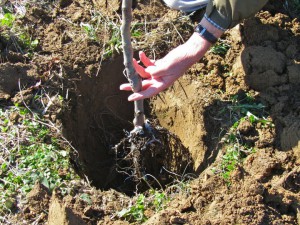
No comments:
Post a Comment
Comments are welcome! All comments are moderated, so you will see your comment posted here as soon as we have reviewed it! Questions are best asked via email for a quicker response. Address your questions to service@royaloakfarmorchard.com.
Note: Only a member of this blog may post a comment.